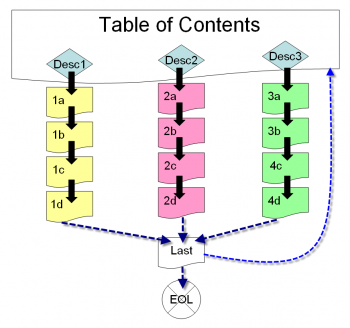The navigation order of lesson pages is the user viewpoint. The navigational order is determined by jumps associated with a users choice, and/or the lesson flow control settings and/or navigational pages in the lesson.
The special navigational pages are advanced features and are called Clusters, end of branch and end of lesson pages.
Examples
Example 1
In this example, there are 10 pages. C1 is a content page (before called a branch page), Q2 is a question page, C3 is a content page, and so on. Here is a edit order of a short lesson:
C1, Q2, C3, Q4,C5, Q6, C7, Q8, C9, Q10.
The instructor may have set the jumps so that after a miss the user goes to the previous page, and a right answer goes to the next page. Thus the user controls the navigational order. For example, if the user missed Q4 and Q6 once, the user navigational order would be
C1, Q2, C3, Q4, C3, Q4, C5, Q6, C5, Q6, C7, Q8, C9, Q10
The instructor might ask a very hard question at Q2 and set the jump for a correct answer to C9. The point is that the navigation order is different than the edit order and the instructor guides the user by jumps. Don’t forget that content pages also can offer user-neutral grade choices by their jumps.
Example 2
We have used the classic Table of Contents to present this concept before. Typically a Content page (Branch Table page) has description buttons that serve as subject headings. In this lesson, there are 3 subjects, each with a series of pages. The instructor will let the user select the order they view the subjects. Notice the “Last” page. This page has two buttons, one which links back to the Table of Content page and the other which goes to the End of Lesson (exits the lesson).

- TIP: Consider when the instructor makes the last page in each series a question and sets and displays the student’s score to alert the user of the potential number of questions. When the instructor sets the next Lesson’s dependency upon completing this Table of Contents lesson with a 100% minimum score, then a user must investigate each of the series before moving on to the next lesson.

